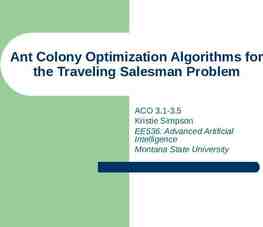Voice over IP AFNOG 2001 Accra – Ghana 12 Mai 2001 By: Adiel AKPLOGAN
21 Slides300.50 KB

Voice over IP AFNOG 2001 Accra – Ghana 12 Mai 2001 By: Adiel AKPLOGAN CAFE Informatique S. A. - TOGO E-mail: [email protected] - Web: http://www.akplogan.net

Topics Definition Standard Requirement QoS Application CAFEnet S.A. (Togo) exemple

Introduction Concern about reduction of communication coast. Voice, Fax and Data integration become a challenge and priority for many network manager. Telecommunication deregulation and Multiservice access network development allow this challenge to be achieve. Today voice over packet network (ATM, Frame Relay and IP) is the one most growing aspect of Multi-service access network

VoIP System Model Voice and signaling transmission using packet network (IP) ITU standard for signaling Model – H.323 ( ITU )- Packet-based Multimedia communication system. SIP (IETF) – Session initiation protocol The voice system resulting from these two standard follow a common Model

VoIP System Model A packet voice system like VoIP follow this model. – A packet network (Internet in most case) – Voice agent at edge of the cloud. Convert voice information from it traditional telephony form to a suitable form for packet transmission. – the packet are send to another voice agent at the call destination.

VoIP system model LAN Voice Agent PABX Voice Agent IP Network Voice Agent Voice Agent

VoIP System Model Two issue from the previous diagram – Voice coding: Voice Packet, Packet Voice – Signaling: who is called and where is the called party on the network?

The two models in brief H.323 Gatekeeper Gateway H.323 terminal MCU SIP UAC (user agent Client) UAS (User agent server) SIP Terminal Proxy Redirect Server Location server

Architecture

Communication

VoIP Addressing As Internet communication is based on IP address (layer 2), every equipment that want to communicate should have an IP address. For VoiP, the voice interface appear as additional IP host. Translation of dial digits from the PBX to an IP host address is performed by the dial plan mapper. The destination telephone number, or some portion of the number, is mapped to the destination IP address.

Voice packet routing and Delay VoIP take advantage of all strong and sophisticate routing protocols of IP (including best route calculation ) But due to the way IP packets are send through the network, the big challenge is the Latency or delay that cause echo and talker overlap.

Voice packet routing and Delay Source of delay include: – Accumulation delay: caused by need to collect a frame of voice samples to be processed by the voice coder (from some microsecond to many milliseconds. – Algorithmic Delay: caused by specific voice encoding delay. – Processing delay: result from the two previous delay plus collecting the sample in to packet for transmission. – Network delay: Processing that occurs as packets are sent across a network.(from protocol, medium, and buffer use to remove packet jitter on the receive side)

Voice packet routing and Delay – Echo: is generated toward the packet network from the telephone network as it always greater than 50 ms, it is not acceptable for good audition. – Jitter: is the variable inter-packet timing cause by the fact that packets do not all cross the network at the same speed. – Lost packet: Under peak load and congestion, voice frame are dropped at the same rate as data frame.

VoIP Signaling Three distinct area: – Signaling from PABX router Network seize the PABZ with any of the signaling used to seize a trunk (as the local network appear to the BABX as a trunk) – FXS or E&M. – Signaling from Router router Dial plan Mapper. – Signaling from Router PABX Line seizure signaling.

VoIP application In today’s networking, there are several attractive alternatives both to conventional public telephony and to leased lines. Among the most interesting are networking technologies based on a different kind of voice transmission, called packet voice and in our case Voice over IP. VoIP can be used in two broad context differentiated by geography or by the type of users to be served.

VoIP application Within a national administration or telephony jurisdiction, – to support its own voice calling among its own sites. – to support the activities of a single company — to connect two or more company locations in multiple countries — – to connect public calls within a company, the packet voice provider is technically providing a local or national telephone service and is subject to regulation as such.

VoIP application Between different administration or telephony jurisdiction – to connect public calls between countries, the packet voice provider is subject to the national regulations in the countries involved and also to any treaty provisions for international calling to which any of the countries served are signatories. Be aware of the valid law applicable in your country until setting up VoIP application to avoid any inconvenience.

VoIP application Example: CAFE Informatique & Telecommunications S.A. – Two application: International Call Communication center – 30 local worker. – Tele-marketing for America and Canadian company – Data scramble for foreign company

VoIP application Architecture du Réseau CAFEnet CISCO 3661 10 FXS ports 2 FXO ports Mail INTERNET DNS Router/firewall RWeb Hosting Network/ SMS/ FAX/Real Audio CACHE Real Audio Producer Local Usage Multimedia and Audio Production Net2Phone IPmax VPN Server Call Center By Adiel AKPLOGAN [email protected]

VoIP Question?






